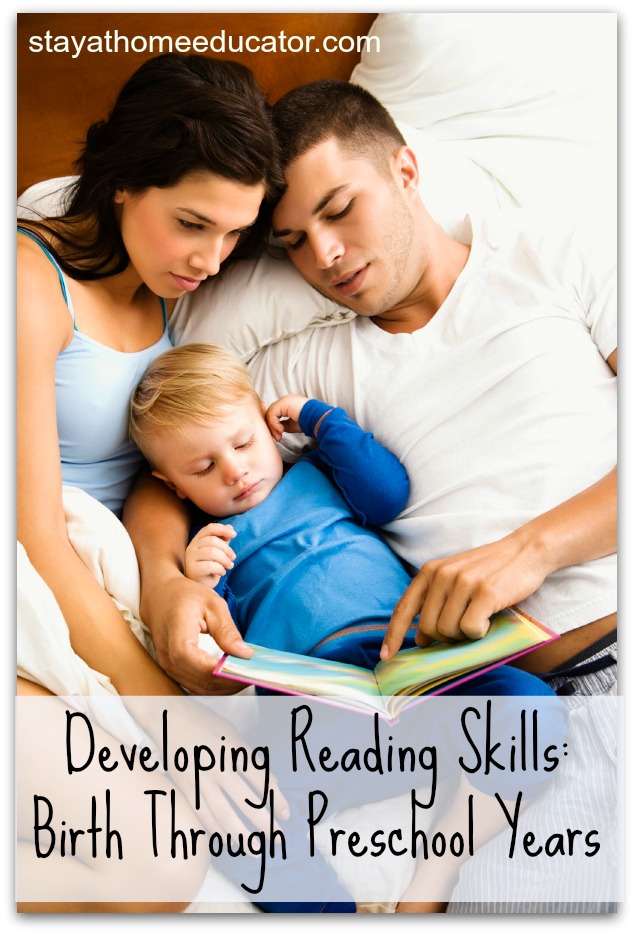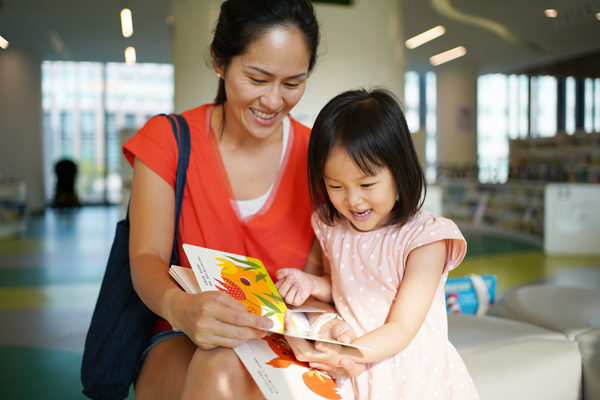There are multiple stages of reading development. This article will walk you through everything that happens in reading development from birth through the preschool years. From tips for reading with your child to teaching letters of the alphabet, we will cover all things related to developing reading skills.
Developing Reading Skills From Birth Through Preschool

When does a child learn to read?
You might answer that children learn after formal reading instruction has begun, usually around kindergarten or first grade in the United States.
But researchers have told us something different. Learning to read and write can start at home, long before children go to school. Children can start down the road to becoming successful readers from the day they are born.
Language acquisition is a complex and fascinating process. It begins in the womb, as babies start to tune into the sounds of their native language. This acquisition is the beginning of developing pre-reading skills.
After birth, they begin to absorb the rhythms and melodies of speech, and to build up a store of basic words and sounds. From there, they start to put words together into simple phrases, and to understand the rules of grammar. Children learn language most easily during the first few years of life, when their brains are growing and changing at an incredible rate.
Children’s earliest experiences with language are critical in shaping their future success as readers and writers.
Related Reading
When adults read stories to them and model reading behavior, children begin to understand the mechanics of written language. They learn that words on a page represent spoken language, and that reading is a way to access new information and ideas.
Additionally, seeing adults read for themselves reinforces the importance of reading as a valued activity. As children grow older, they build on these early experiences and learn to read and write independently.
However, without those initial exposure to spoken and written language, they would be at a significant disadvantage. Therefore, it is crucial that adults take the time to speak and read with their children on a regular basis.

The Basic Building Blocks of Developing Reading and Writing
Research has demonstrated time and again that for children to build reading skills — for them to become confident and skilled readers, they need multiple opportunities in the following:
- build spoken language skills via listening and speaking
- learn about books and various forms of print
- learn about the sounds in spoken language
- letters of the alphabet
- listen to books read aloud
Developing Reading Skills in Babies
Young babies quickly begin to make associations with the sound of specific words and meaning.
Their faces may light up with excitement at the mention of the word “puppy” or “park” and they may shriek in delight at the phrase, “Daddy is home!” Even as young as babyhood, children are developing reading skills as their language skills develop.
At first, children delight in interactive songs, rhymes and finger plays. Experts strongly encourage parents to play peek-a-boo and patty-cake with their babies. Some doctors even use that same parent-baby interaction to determine if baby if developing as he should be.
Before a year of age, it is common for babies to have a strong interest in board books or alphabet blocks, even if these literacy tools are used mostly for teething relief.
Reading Skills in Babies (0-12 Months)
- Reach for soft-covered books or board books
- Look at and touch the pictures in books
- Respond to a stories and books by cooing or making sounds
- Help turn pages

Developing Reading Skills in Toddlers
Once children grow out of the baby stage and can be identified as a toddlers, they learn that the symbols associated with language and their toys carry meaning.
At first, they use physical and visual clues surrounding the print to identify meaning. They recognize McDonald’s not by the letters in the word but by the familiar golden arches. They recognize a stop sign not by the letters s-t-o-p, but by the bright red octagon at an intersection. This is called environmental print and it is a very important pre-reading skill.
During the toddler years, children also may become interested in letters, particularly those in their own name.
Reading Skills in Toddlers (13-35 Months)
- Look at pictures and name familiar items, like dog, cup, and baby
- Answer questions about what they see in illustrations
- Recognize the covers of favorite books
- Recite the words to well-known books
- Pretend to read by turning pages and making up stories

Developing Reading Skills in Preschoolers
As children grow from toddlers and into the preschool years, they begin to make more specific associations, such as the understanding that letters are symbols that represent meaning or sounds.
They learn that letters have meaning and sounds. Multiple letters make up words, and multiple words are found in books, magazines and on lists. Preschool aged children may begin to identify letters and process their sounds, connecting their spoken word with meaning.
This is known as the alphabetic principle and studies suggest children benefit most from systematic and explicit instruction in the alphabet and phonics.
Preschoolers (ages 3–4 years)
- Correctly hold and handle a book
- Understand left to right progression in reading
- Start noticing words that rhyme
- Retell stories
- Identify letter names
- Identify letter sounds
- Recognizes own name and can possibly write it

Activities to Develop Reading Skills
It is never too early to start developing reading skills. In fact, there are a number of activities that can be done from birth to preschool to help children develop the skills they need to become successful readers.
Talking and Listening
Remember the old saying “children should be seen and not heard”?
In the past, children were often expected to be quiet and well-behaved, especially in public places. However, research tells us that for children to become readers, they need to listen and talk a lot.
According to literacy experts, hearing stories and talking about them is essential for developing reading skills.
By the time children are one year old, they already know a lot about spoken language. They recognize some speech sounds and begin to imitate those sounds.
Children learn all of this by listening to family members talk. Even “baby talk,” which exaggerates the sounds and rhythms of words, makes a contribution. Baby talk is important because it helps children learn the basic sounds of language.
As they get older, children begin to put words together to form simple sentences. By age 3 or 4, most children can say many words and put two or three words together in a sentence. Their sentence structure is simple, but they are beginning to express their thoughts in ways that others can understand.
Children’s ability to communicate improves rapidly during the preschool years as they gain more experience with spoken language. By school age, most children can easily carry on a conversation. They have a large vocabulary and can use language in variety of ways to express their thoughts and feelings.
Related Reading
Read Aloud to Your Child and Talk About the Stories
While there are many instructional systems that can prepare a child to read, research suggests that the single most important activity that aides in the building of pre-reading skills is being read to. Parents should choose books of high quality that allow both parent-child participation.
Asking predictive and analytical questions will increase vocabulary and reading comprehension. Experts agree that children should talk about the pictures, retell stories, discuss their favorite parts, and request multiple readings of the same stories. It is the talk that surrounds storybook reading that influences pre-reading skills, helping children bridge stories they read with their own lives.
Parents should choose books of high quality that allow both parent-child participation. Asking predictive and analytical questions will increase vocabulary and comprehension.
Experts agree that children should talk about the pictures, retell stories, discuss their favorite parts, and request multiple readings of the same stories. It is the talk that surrounds storybook reading that influences pre-reading skills, helping children bridge stories they read with their own lives.
This in turn encourages children to move beyond themselves to what they can imagine as well.
Related Reading
Provide Opportunities to Play With Letters and Print
Another beneficial activity for young children to develop reading skills is the opportunity to use what they have learned. They need to practice what they know about print.
This may take many forms. Children can participate in dramatic play where they imitate characters and roles from familiar books. They may pretend read by retelling a familiar story by the use of pictures. They may scribble or draw lines in efforts of writing notes, stories and labels.
Allowing unlimited access to personal libraries in the home and regular visits to the school or public library are also encourages. All these activities have been proven to help promote the life long love of reading.
Related Reading
Provide a Print Rich Environment
Most importantly, experts agree that the best way to develop reading skills in the birth to preschool age years, and the best way to promote reading readiness is to expose children to an environment rich with print.
This means that books are always available, toy bins are labeled, a picture-word routine or schedule is posted. A rich print environment also means that children are exposed to the various form of print through the modeling of parents and adults.
Children should see adults reading and writing, making lists and referring to specific labeled items, such as a specific box of cereal in the pantry. Homes filled with language and a wide variety of print, literacy play, storybook reading, and writing allow children to experience to joy of reading and writing while practicing and mastering the basic concepts of pre-reading skills that are such strong indicators of future reading success.

I’m Sarah, an educator turned stay-at-home-mama of five! I’m the owner and creator of Stay At Home Educator, a website about intentional teaching and purposeful learning in the early childhood years. I’ve taught a range of levels, from preschool to college and a little bit of everything in between. Right now my focus is teaching my children and running a preschool from my home. Credentials include: Bachelors in Art, Masters in Curriculum and Instruction.


[…] Learning to read and write is an ongoing process from infancy. (You can read more about that here.) […]